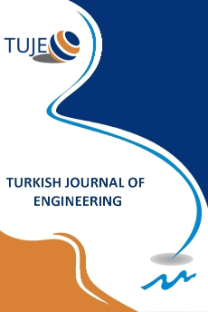EXPERIMENTAL INVESTIGATION OF A NOVEL FRICTION MODIFIER IN COMPOSITE MATERIALS
EXPERIMENTAL INVESTIGATION OF A NOVEL FRICTION MODIFIER IN COMPOSITE MATERIALS
___
- Akıncıoğlu, G., Öktem, H., Uygur, I., Akıncıoğlu. S. (2018). “Determination of Friction-Wear Performance and Properties of Eco-Friendly Brake Pads Reinforced with Hazelnut Shell and Boron Dusts.” Arabian Journal for Science and Engineering 43: 4727–37. https://doi.org/10.1007/s13369-018-3067-8.
- Bijwe, J., Aranganathan, N., Sharma, S., Dureja, N., Kumar, R. (2012). “Nano-Abrasives in Friction Materials-Influence on Tribological Properties.” Wear 296: 693–701. https://doi.org/10.1016/j.wear.2012.07.023.
- Ghazali, C. M. R., Kamarudin, H., Jamaludin, S. B., Abdullah, M. M. A. (2011). “Comparative Study on Thermal, Compressive, and Wear Properties of Palm Slag Brake Pad Composite with Other Fillers.” Advanced Materials Research 328–330: 1636–41.
- Ibhadode, A. O. A., Dagwa, I. M. (2008). “Development of Asbestos-Free Friction Lining Material from Palm Kernel Shell.” Journal of the Brazilian Society of Mechanical Sciences and Engineering 30 (2): 166–73.
- Idris, U. D., Aigbodion, V. S. (2015). “Eco-Friendly Asbestos Free Brake-Pad : Using Banana Peels.” Journal of King Saud University - Engineering Sciences 27 (2): 185–92. https://doi.org/10.1016/j.jksues.2013.06.006.
- Ikpambese, K. K., Gundu, D. T., Tuleun. L. T., (2016). “Evaluation of Palm Kernel Fibers (PKFs ) for Production of Asbestos-Free Automotive Brake Pads.” Journal of King Saud University - Engineering Sciences 28 (1): 110– 18. https://doi.org/10.1016/j.jksues.2014.02.001.
- Kahraman, F., Sugözü B. 2019. “An Integrated Approach Based on the Taguchi Method and Response Surface Methodology to Optimize Parameter Design of AsbestosFree Brake Pad Material.” Turkish Journal of Engineering 3 (3): 127–32.
- Kim, Y. C., Cho, M. H., Kim, S. J., Jang, H. (2008). “The Effect of Phenolic Resin, Potassium Titanate, and CNSL on the Tribological Properties of Brake Friction Materials.” Wear 264 (3–4): 204–10. https://doi.org/10.1016/J.WEAR.2007.03.004.
- Kukutschová, J., Roubíček, V., Malachová, K., Pavlíčková, Z., Holuša, R. Kubačková, J. Mička, V. MacCrimmon, D., Filip, P. (2009). “Wear Mechanism in Automotive Brake Materials, Wear Debris and Its Potential Environmental Impact.” Wear 267 (5–8): 807– 17. https://doi.org/10.1016/J.WEAR.2009.01.034.
- Leonardi, M., Menapace, C., Matějka, V., Gialanella, S., Straffelini, G. (2018). “Pin-on-Disc Investigation on Copper-Free Friction Materials Dry Sliding against Cast Iron.” Tribology International 119 (March): 73–81. https://doi.org/10.1016/J.TRIBOINT.2017.10.037.
- Li, Z., He, M., Dong, H., Shu, Z., Wang, X. (2018). “Friction Performance Assessment of Non-Asbestos Organic (Nao) Composite-To-Steel Interface and Polytetrafluoroethylene (PTFE) Composite-To-Steel Interface: Experimental Evaluation And Application In Seismic Resistant Structures.” Construction and Building Materials 174: 272–83.
- Ravikiran, A., Jahanmir., S. (2001). “Effect of Contact Pressure and Load on Wear of Alumina.” Wear 251 (1– 12): 980–84. https://doi.org/10.1016/S0043-1648(01)00739-6.
- Shin, M. W., Cho, K. H., Lee, W. K., Jang, H. (2010). “Tribological Characteristics of Binder Resins for Brake Friction Materials at Elevated Temperatures.” Tribology Letters 38 (2): 161–68.
- Sugözü, İ., Kahya, K. (2018). “Investigation of the Effect on Tribological Properties of the Use of Pinus Brutia Cone as a Binder in Brake Pads.” European Mechanical Science 2 (4): 115–18. https://doi.org/10.26701/ems.471131.
- Sugozu, I., Mutlu, I., Sugozu, B. (2018). “The Effect of Ulexite to the Tribological Properties of Brake Lining Materials.” Polymer Composites 39 (1): 55–62. https://doi.org/10.1002/pc.23901.
- Sugözü, İ., Mutlu, İ., Sugözü, B. (2016). “The Effect of Colemanite on the Friction Performance of Automotive Brake Friction Materials.” Industrial Lubrication and Tribology 68 (1): 92–98. https://doi.org/10.1108/ILT-04- 2015-0044.
- TSE 555. 1992. Highway Vehicles-Brake System-Brake Pads for Friction Brake. Ankara, Turkey.
- Yawas, D S, Aku, S. Y., Amaren., S. G. (2016). “Morphology and Properties of Periwinkle Shell Asbestos-Free Brake Pad.” Journal of King Saud University - Engineering Sciences 28 (1): 103–9. https://doi.org/10.1016/j.jksues.2013.11.002.
- ISSN: 2587-1366
- Yayın Aralığı: 4
- Başlangıç: 2017
- Yayıncı: Mersin Uüniversitesi
EXPERIMENTAL INVESTIGATION OF A NOVEL FRICTION MODIFIER IN COMPOSITE MATERIALS
İlker Fatih KARA, Ashraf F. ASHOUR, Cahit BİLİM
BEHAVIOR OF R/C FRAMES WITH CONCRETE PLATE BONDED INFILLS
ÇİĞDEM ACI, EREN YILDIZ, Esra Saraç EŞSİZ
AUTOMATIC DETECTION OF CYBERBULLYING IN FORMSPRING.ME, MYSPACE AND YOUTUBE SOCIAL NETWORKS
Eren Çürük, Çiğdem İnan Acı, Esra Saraç Eşsiz
LOGIC THRESHOLD FOR MICRORING RESONATOR-BASED BDD CIRCUITS: PHYSICAL AND OPERATIONAL ANALYSES
